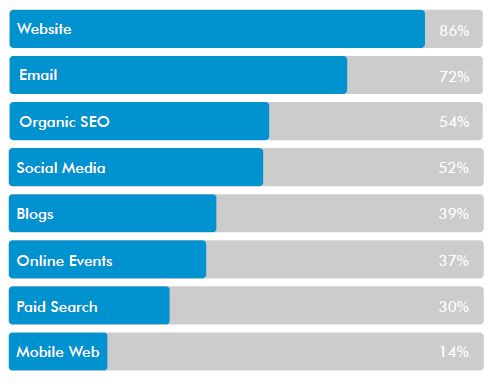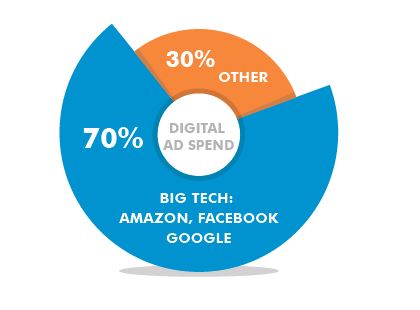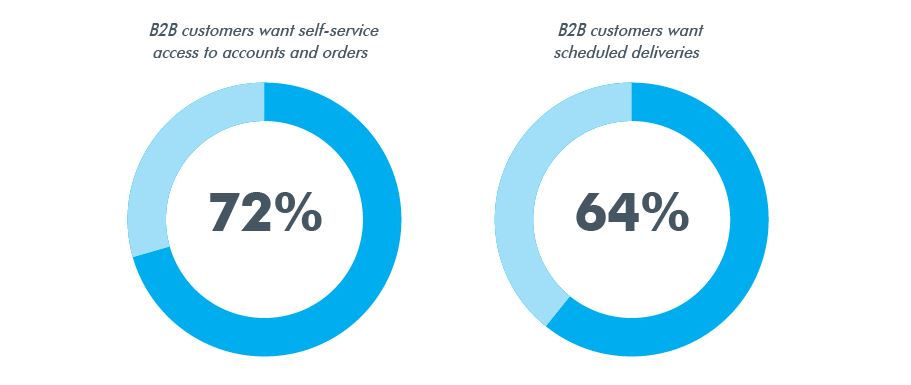The B2B E-commerce industry is continuing to expand with thousands of businesses entering the online market each year.
Technology advancements and innovations in the B2B ecommerce website design and development have been playing a big role in this growing industry, which makes B2B buyers expect more intuitive and faster tools to simplify processes and improve their purchasing experiences.
Now more than ever B2B Ecommerce businesses need to step up their game not only to fill their buyers needs but to also stay ahead of the competition. With that in mind, we put together a list of the top 20 B2B Ecommerce Trends for 2020:
1. Better B2B Ecommerce Tools
B2B ecommerce platforms that meet most of B2B requirements are becoming plentiful and cost effective. Suppliers such as Magento, Salesforce and NetSuite are providing true B2B functionality out of the box that can be customized for your
specific business requirements.
2. Personalization delivered today
Imagine the shopping experience where your customers can conveniently review their past orders and then re-order with a one-button click, check prices and discounts, create their own wish lists, have their own custom catalogue, manage their profiles
and review and pay their invoices online.
3. Reduce costs even more
According to Forrester Research, self-service ecommerce features can reduce sales costs up to 90%. The automated selling process provided by an ecommerce website helps B2B companies save time and effort. Also, minimize human errors and avoid costly mistakes.
4. Quote and Order Management systems
These new tools support both the complex B2B sales process and the sales team with dynamic quotes, effectively handling the back and forth with customers. Quoting and approval processes are managed with the click of a button. Turn a quote into an order while saving time and money.
5. Powerful Product Search Tools
Product search systems and filtering options are improving dramatically, allowing customers to easily and quickly find and buy products by specifications, SKUs, prices, availability and other detailed attributes.
6. Ecommerce System as a PIM
Using your ecommerce platform as a central repository for your product data is now commonplace. Many platforms have the capabilities and features of a professional Product Information Management (PIM) system and can easily organize your product data for other applications or systems.
7. Complex Pricing Options
Some ecommerce systems now understand and deliver the complex pricing needed for B2B transactions, including: by retail price; by group; by customer; special offers; date-sensitive pricing; quantity discounts; bulk discounts; taxes; shipping and more.
Most Effective B2B Ecommerce Online Marketing Channels

8. Custom Catalogues
Quote and Order Management systems Create custom catalogues for different countries, customer groups and individual customers. All of this can be done through one master product catalogue and ecommerce system, ensuring highly efficient product data management.
9. Portable Product Data
Ecommerce product data can feed and integrate with ERP, inventory systems, POS, marketing collateral, technical specs and safety sheets. Also don’t forget the opportunity to provide product data to Amazon Business, eBay, niche online marketplaces and your distributors and retailers.
10. Mobile Matters Even More
Over 50% of all traffic and 40% of purchases are now made on a smartphone. Mobile users on B2B ecommerce sites are purpose-driven and the user experience should take that into consideration. Mobile users spend less time on the site, visit fewer pages per session and have a higher bounce rate.

11. Self-Service and Sales Reps
B2B buyers increasingly prefer the option to self-serve online - researching, finding, buying, managing their accounts and orders through a single Web-based platform. B2B companies still need to have a knowledgeable sales rep available to help when needed.
12. Voice Search & Smart Assistants
The B2B purchasing cycle is complex and will continue to be a challenge when adopting voice technology, but the high number of repeat orders in B2B is a clear opportunity for businesses to use voice technology to streamline the order and fulfillment processes.
13. Specialized Marketplaces
Some B2B buyers prefer focused marketplaces where they can easily source from multiple vendors. Expect to see a surge in niche marketplaces that provide extensive product selection, customized experiences, effective customer journeys and competitive transaction fees.
14. Brands Are Wary of Big Tech
Google, Facebook and Amazon account for 70% of digital ad spend budgets and they are yielding fewer results for long-term, sustainable business growth. B2B companies will need marketing channels within their control to develop direct personal relationships with their customers.
15. Online Chat
Almost half of customers would rather connect with a company via live chat than any other means of contact. Live chat provides an excellent option for B2B ecommerce stores to provide immediate support, to answer questions and guide visitors to the right purchase decision.
16. Progressive Web Apps
Want the look, feel and capabilities of a web app but without the extra time and expense of developing and maintaining apps for two different operating systems? PWAs accomplish this by providing a reliable, fast and engaging user experience that can also be accessed offline.
17. Content Marketing
The B2B customer has a need for relevant and helpful information. Google and your customers will reward you for proving valuable and relevant content. Leveraging of re-purposed content into different formats is also smart marketing.

18. Headless Ecommerce
It means a system that stores, manages and delivers content without a single front-end delivery layer. ECommerce brands can deliver page content, product information and payment gateways to smartwatches, kiosk screens, Alexa and everything in between more easily.
19. Easy Shipping & Payment
B2B websites can store billing and shipping options which makes it extremely easy and quick for customer checkout. There are many payment and shipping variables and the new tools make it easy to setup and manage these complex requirements.

20. Price Transparency
Why do B2B buyers say good-bye? Non-competitive pricing is the top factor according to research conducted by Accenture. This means your modern B2B buyers will make price transparency and low cost a must-have online versus a nice-to-have according to Forrester Research.

If your B2B company is considering implementing an ecommerce platform or upgrading an existing one, make sure you follow these trends and choose a smart ecommerce tool tailored for your unique business needs.
At Graphically Speaking, we are committed to helping your business develop a B2B ecommerce website that will encourage your buyers to easily accomplish their goals. Explore our B2B portfolio to learn more and contact us to learn how we can help you start or improve your B2B ecommerce website.